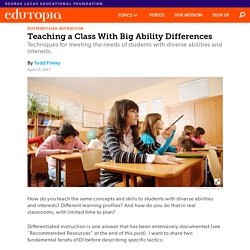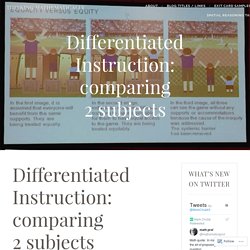

Distance Learning with Carol Ann Tomlinson. What Differentiated Instruction Is Not: A Teacher's Perspective. Opinion —Robert Nuebecker for Education Week By Chad Towarnicki.

How to Differentiate Instruction (Without Losing Your Mind) - Teaching Now. What Neuroscience Can Tell Us About Making Fractions Stick. Teaching a Class With Big Ability Differences. How do you teach the same concepts and skills to students with diverse abilities and interests?

Different learning profiles? And how do you do that in real classrooms, with limited time to plan? Differentiated instruction is one answer that has been extensively documented (see “Recommended Resources” at the end of this post). I want to share two fundamental tenets of DI before describing specific tactics: Differentiation is a method of instruction designed to meet the needs of all students by changing what students learn (content), how they accumulate information (process), how they demonstrate knowledge or skills (product), and with whom and where learning happens (learning environment). With that in mind, here are specific techniques you can use to meet the needs of students with a range of abilities. 1. Experiencing comprehensive student-centered instruction for the first time makes some kids uneasy. 2. 3.
Choice is motivating and empowering. 4. 5. 6. Recommended Resources. Differentiating Instruction: It’s Not as Hard as You Think. The D Word. In the course of my work with teachers, I'm often asked about a little something called differentiation.

Maybe you've heard of it. They might say something like: Admin is requiring us to have differentiation options in our lesson plans. What's a good way to account for all the levels of learners in my class? More often than not they won't use the d word. They'll say something along the lines of: I've got a lot of low kids in my class. One common method I've seen employed is dividing students into ability-based groups. Step One: Grab a scissors. Step Two: After a quick notice and wonder, ask the students to write their own questions, questions that can be solved using the information in the prompt. Differentiation an article of faith. Succeeding With Differentiation. Targeted Instruction. The other day I was asked about my opinion about something called entrance slips.

Curious about their thoughts first, I asked a few question that helped me understand what they meant by entrance slips, what they would be used for, and how they might believe they would be helpful. The response made me a little worried. Basically, the idea was to give something to students at the beginning of class to determine gaps, then place students into groups based on student “needs”. I’ll share my issues with this in a moment… Once I had figured out how they planned on using them, I asked what the different groups would look like. Differentiated Instruction: comparing 2 subjects. I’ve been thinking a lot about how to meet the various needs of students in our classrooms lately.

If we think about it, we are REALLY good at differentiated instruction in subjects like writing, yet, we struggle to do differentiated instruction well in subjects like math. Why is this??? In writing class, everyone seems to have an entry point. The teacher puts a prompt up on the board and everyone writes. The TeachThought Podcast Ep. 100 So All Can Learn: A Practical Guide To Differentiation - How to Fall In Love with the word RIGOR. I felt really frustrated with word study so far this year.

My class is made up of two types of kids right now: ones that know ALL their letters and sounds and ones that literally know like, three. Everyone around me is teaching via centers/stations but friends, if you've followed me at all then you know that centers are NOT MY JAM. I was jaded my second year teaching when I worked at a school that had a solid 5 center a week rotation. I printed, copied them on 5 different colors of paper, laminated, cut, baggied, and labeled them all so I could spend my time screaming at poor children who failed return all of the pieces that had been printcopylaminatecutbaggied and left them on the floor. HOW DARE YOU LEAVE THE GREEN WORD CARD ON THE FLOOR! Differentiated Instruction: comparing 2 subjects. Co-Teaching in Math Class – Thinking Mathematically.
For the past few years I have had the privilege of being an instructional coach working with amazing teachers in amazing schools. It is hard to explain just how much I’ve learned from all of the experiences I’ve had throughout this time. The position, while still relatively new, has evolved quite a bit into what it is today, but one thing that has remained a focus is the importance of Co-Planning, Co-Teaching and Co-Debriefing. This is because at the heart of coaching is the belief that teachers are the most important resource we have – far more important than programs or classroom materials – and that developing and empowering teachers is what is best for students. Rug Partners: Grade School Student Warm Up Strategy. How to Differentiate Academically Diverse Classrooms. 7 Reasons Why Differentiated Instruction Works.
Differentiated instruction (DI) begins with an accurate understanding of what DI is—and is not.

You may be surprised how easy it is to incorporate into your classrooms. 1. Differentiated instruction IS proactive. In a differentiated classroom, the teacher assumes that different learners have differing needs and proactively plans lessons that provide a variety of ways to “get at” and express learning. The teacher may still need to fine tune instruction for some learners, but because the teacher knows the varied learner needs within the classroom and selects learning options accordingly, the chances are greater that these experiences will be an appropriate fit for most learners. Effective differentiation is typically designed to be robust enough to engage and challenge the full range of learners in the classroom. 2.
Many teachers incorrectly assume that differentiating instruction means giving some students more work to do, and others less. 3. 4. 5. 6. 7. Teaching a Class With Big Ability Differences. 5 Fallacies That Are NOT Differentiated Instruction.